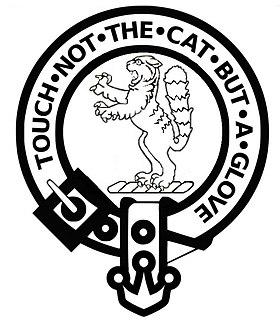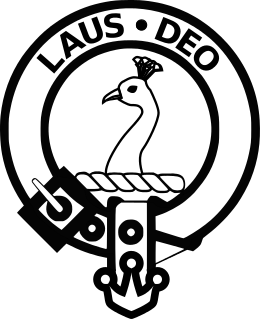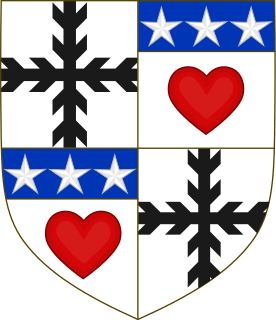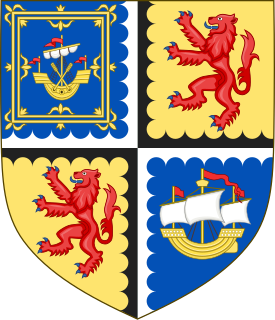
Auchindoun Castle is a 15th-century L-Plan tower castle located in Auchindoun near Dufftown in Banffshire, Scotland.

Clan Farquharson is a Highland Scottish clan based at Invercauld, Aberdeenshire and is a member of the Chattan Confederation.

Clan Chattan is a unique confederation of Highland clans. The clan is distinctive in highland clan history in that it was acknowledged to be a community or confederation, of twelve separate Scottish clans, who each had their own clan chief recognized under Scottish law, but who were united under and bound to a superior chief of the confederation for mutual solidarity, sustenance and protection in the Middle Ages and early modern period in the Scottish Highlands.

Clan Mackintosh is a Scottish clan from Inverness in the Scottish Highlands. The chiefs of the clan are the Mackintoshes of Mackintosh. Another branch of the clan, the Mackintoshes of Torcastle, are the chiefs of Clan Chattan, a historic confederation of clans.

Clan Arbuthnott is a Lowland Scottish clan.

Clan MacNeacail, sometimes known as Clan MacNicol, is a Scottish clan long associated with the Isle of Skye. Tradition states that, early in its history, the clan held the Isle of Lewis, as well as extensive territory on the north-western mainland. The earliest member of the clan on record is one 14th century John "mak Nakyl", who is recorded amongst Edward I of England's powerful West Highland supporters during the Wars of Scottish Independence. John Barbour's 1375 epic, The Brus, suggests that by 1316, the clan had switched allegiance to Robert I, and made a decisive intervention in the new theatre of Anglo-Scottish conflict in Ireland. The marriage of an heiress to the MacLeods of Lewis brought a severe loss of lands and power in the following generation, forcing the clan chiefs to relocate to the surviving estates on Skye. However, the MacNeacails retained local significant influence: serving, according to tradition, as members of the Council of the Lords of the Isles and as custodians of the cathedral church of the Western Isles at Snizort. In the 17th century, members of the clan began to Anglicise their surname from the Scottish Gaelic MacNeacail to various forms, such as Nicolson. Today the English variants of the Gaelic surname are borne by members of the clan as well as members of unrelated Scottish families, including the Lowland Clan Nicolson.

Clan Gordon, also known as the House of Gordon, is a Scottish clan. The chief of the clan is the powerful Earl of Huntly, and now also the Marquess of Huntly. During the Wars of Scottish Independence in the 13th century, the Gordons supported William Wallace in the cause of independence. In the 15th century, the chiefship of the clan passed to an heiress, who married into the Seton family and her male descendants assumed the surname Gordon and continued as chiefs of the clan. The Gordons assisted in defeating the rebellion of the Earl of Douglas also in the 15th century. In the 16th century, the Gordons as Catholics feuded with their Protestant neighbors the Clan Forbes and also defeated at the Battle of Glenlivet, the Protestant Earl of Argyll. During the Wars of the Three Kingdoms of the 17th century, the Gordons supported the Royalist cause. During the Jacobite rising of 1715 the Clan Gordon was Jacobite. During the Jacobite rising of 1745, their chief, then the Duke of Gordon, pledged his support to the British-Hanoverian Government, but his clan remained Jacobite.

Clan Cameron is a West Highland Scottish clan, with one main branch Lochiel, and numerous cadet branches. The Clan Cameron lands are in Lochaber and within their lands lies Ben Nevis which is the highest mountain in the British Isles. The Chief of the clan was historically Lord Lochiel, but customarily referred to as simply the "Lochiel".

Clan Douglas is an ancient clan or noble house from the Scottish Lowlands.

Castle Chanonry of Ross, also known as Seaforth Castle, was located in the town of Fortrose, to the north-east of Inverness, on the peninsula known as the Black Isle, Highland, Scotland. Nothing now remains of the castle. The castle was also known as Canonry or Chanonrie of Ross, the former county.

Clan Colville is a Lowland Scottish clan.

Clan MacBean, is a highland Scottish clan and is a member and historic sept of Clan Chattan.

Clan Maitland is a Lowland Scottish clan.

Sir William Douglas of Glenbervie, Knt. was a Scottish nobleman, who fell at Flodden.

Sir Archibald Douglas of Glenbervie was a Scottish nobleman.
Robert Mor Munro, 15th Baron of Foulis, and 18th chief of the Clan Munro was a 16th-century Scottish chief. He was known as Robert Mor on account of his large stature. He was the eldest son of Robert Munro, 14th Baron of Foulis. Although this Robert Munro is traditionally 15th Baron and 18th overall chief of the clan, he is only the 8th Munro chief that can be proved by contemporary evidence.

John Sinclair was a Scottish nobleman, 3rd Earl of Caithness and chief of the Clan Sinclair, a Scottish clan of the Scottish Highlands.

Clan Munro is a Highland Scottish clan. Historically the clan was based in Easter Ross in the Scottish Highlands. Traditional origins of the clan give its founder as Donald Munro who came from the north of Ireland and settled in Scotland in the eleventh century, though its true founder may have lived much later. It is also a strong tradition that the Munro chiefs supported Robert the Bruce during the Wars of Scottish Independence. The first proven clan chief on record however is Robert de Munro who died in 1369; his father is mentioned but not named in a number of charters. The clan chiefs originally held land principally at Findon on the Black Isle but exchanged it in 1350 for Estirfowlys. Robert's son Hugh who died in 1425 was the first of the family to be styled "of Foulis", despite which clan genealogies describe him as 9th baron.
Sir George Auchinleck, Lord Balmanno MP (c.1560–c.1640) was a 16th/17th century Scottish politician, judge and Senator of the College of Justice.
William Mackintosh, 13th of Mackintosh was the chief of the Clan Mackintosh, a Scottish clan of the Scottish Highlands. He was also chief of the confederation of clans that was known as the Clan Chattan.















